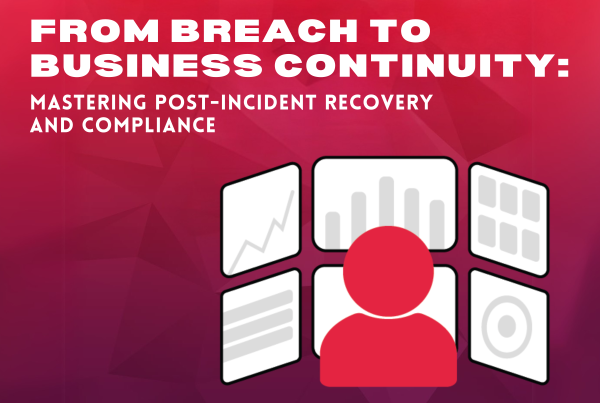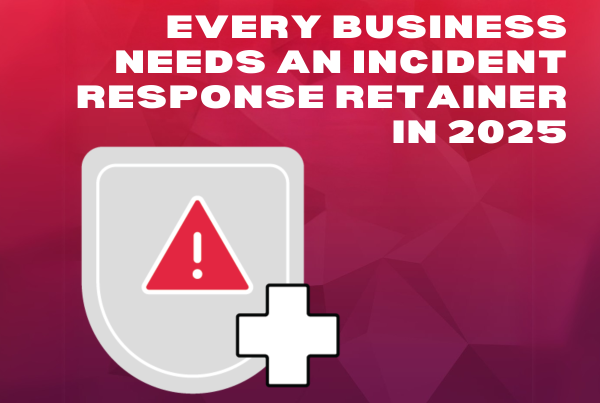Introduction
Cyber attacks have moved beyond isolated IT problems. In 2025, they disrupt supply chains, cripple financial systems, and halt manufacturing lines overnight. Organizations that only invest in preventative security tools often find themselves paralyzed when a breach occurs. Without resilience, every hour of downtime drains revenue, damages relationships with customers, and exposes leadership to regulatory penalties.
Cyber resilience changes that outcome. It equips businesses to keep operating even while under attack, limit the reach of a breach, and recover faster than competitors. IPV Network works with executives and technical teams to build this resilience into daily operations. Instead of reacting to cyber threats, businesses gain the capability to anticipate, absorb, and adapt to them without losing control of their mission.
I. Why Proactive Cyber Resilience Planning Matters
Too many businesses still approach cybersecurity as a purely defensive exercise. They rely heavily on tools designed to block intrusions or detect malicious activity, assuming that prevention alone is enough to keep operations safe. But the methods used by today’s attackers are built specifically to evade those defenses. Credential harvesting, social engineering, supply chain compromise, and exploitation of unmanaged assets routinely bypass even well-maintained controls. By the time a threat is detected, it’s often too late to prevent real damage. This is where the difference between a reactive organization and a resilient one becomes clear.
When a breach occurs, the impact isn’t limited to technical disruption. Financial losses mount by the hour. Legal exposure begins the moment sensitive data is compromised. Customers demand answers, regulators expect documentation, and executives are forced to make fast decisions under pressure. In organizations without a resilience plan, this often leads to delays, uncertainty, and conflicting priorities. No one is sure who has authority to act, what steps to take first, or how to contain the situation without making it worse. In many cases, leadership hesitates, legal teams freeze communication channels, and the attackers continue moving freely inside the network.
Proactive resilience planning is the solution to this breakdown. It gives every stakeholder a clear path forward before the crisis begins. A well-structured plan assigns ownership of critical decisions, defines escalation protocols, and establishes communication guidelines for both internal coordination and external disclosures. But planning on paper isn’t enough. Organizations must pressure-test their playbooks through tabletop exercises and live-response simulations. These not only validate the plan’s effectiveness but also prepare teams to work together under real-world stress. Response becomes a matter of execution, not improvisation.
Technical readiness is just as critical. Resilient organizations maintain isolated, regularly tested backups that cannot be tampered with during an attack. Logging infrastructure is configured to preserve evidence without alerting the attacker. Endpoint controls are hardened against lateral movement. Network visibility is sufficient to detect unusual behavior early. These systems must be designed and verified before an incident ever takes place. IPV Network partners with clients to build this technical foundation, aligning it with governance structures, compliance obligations, and operational realities. Without these measures in place, response efforts are delayed, evidence is lost, and recovery is longer and more expensive than it should be.
II. Six Pillars of an Effective Cyber Resilience Program
Building cyber resilience is not achieved by a single policy or security product. It requires a deliberate, organization-wide program that strengthens technical defenses, decision-making processes, and human readiness. IPV Network has identified six foundational pillars that, when implemented together, enable businesses to withstand and recover from modern cyber attacks effectively.
1. Comprehensive Risk Assessment and Business Impact Analysis
Cyber resilience begins with knowing what is most important to protect. Many organizations do not have a current, detailed understanding of which assets are most critical to operations, which systems are most vulnerable, and how different types of attacks could disrupt the business. A comprehensive risk assessment examines these factors, mapping potential attack paths and identifying high-value targets for attackers. Business impact analysis takes this further by quantifying operational and financial losses tied to downtime or data breaches. This combination allows leadership to prioritize investment and response planning where it matters most.
2. Tailored Incident Response Playbooks
Generic plans rarely work during a live incident. An effective program includes detailed, role-specific playbooks for common and emerging attack scenarios, such as ransomware, phishing-driven credential theft, insider threats, and distributed denial-of-service (DDoS) attacks. These playbooks outline every stage of response, from detection and containment through investigation, communication, and recovery. They define responsibilities for technical teams, executives, legal counsel, communications staff, and third-party partners. IPV Network designs these playbooks with clients to ensure that actions are executable, legally sound, and aligned with regulatory requirements.
3. Regular Testing and Simulation Exercises
Written plans must be tested under realistic conditions. Tabletop exercises bring together leadership, IT, security teams, and external experts to rehearse decision-making during simulated breaches. Advanced resilience programs also include live drills, sometimes called red-team or blue-team exercises, where ethical attackers attempt to breach defenses while defenders practice containment and eradication. These exercises reveal weaknesses in technology, processes, and communications that would not be visible on paper. Continuous testing builds team confidence and shortens real-world response times.
4. Threat Intelligence and Continuous Monitoring
Cyber resilience requires staying ahead of attacker tactics. Integrating actionable threat intelligence enables organizations to identify emerging risks, understand adversary techniques, and anticipate how attacks may evolve. Continuous monitoring using security information and event management (SIEM) tools, endpoint detection and response (EDR) systems, and network telemetry ensures that unusual activity is flagged quickly. Mapping detections to frameworks such as MITRE ATT&CK provides context for threats and informs proactive defenses. IPV Network incorporates threat intelligence into resilience programs to help organizations adapt faster than attackers.
5. Workforce Security Awareness and Specialized Training
Employees are both the first line of defense and a potential vulnerability. A mature resilience program includes organization-wide security awareness campaigns, regular phishing simulations, and targeted training for staff in sensitive roles. Beyond general awareness, key personnel such as system administrators, incident commanders, and communications officers receive specialized training on their responsibilities during a cyber crisis. This ensures that when an attack occurs, employees recognize early warning signs, escalate them properly, and execute response plans effectively.
6. Post-Incident Review and Continuous Improvement
Every incident provides lessons that should be used to strengthen defenses. A resilient organization treats post-incident reviews as essential, not optional. Forensic investigations detail how the attack unfolded, where controls failed, and which responses worked. Reports are analyzed by leadership, legal, and technical teams to identify improvements. Playbooks are updated, new security controls are implemented, and staff are retrained based on findings. This cycle of learning and refinement builds long-term resilience, ensuring that the same vulnerability is not exploited twice.
IV. Building Long-Term Cyber Resilience and Measuring Success
Cyber resilience is not a short-term project. It is an ongoing capability that must evolve with technology changes, regulatory demands, and new attacker methods. Organizations that treat resilience as a one-time effort lose their readiness as threats shift. IPV Network helps clients establish resilience as a sustained, measurable part of their overall operational strategy. ‘
1. Embedding Resilience Across the Business
Resilience cannot be confined to IT teams alone. Finance, legal, operations, communications, and human resources must all be prepared to support business continuity during an incident. IPV Network integrates cybersecurity planning with enterprise risk management so that every department contributes to maintaining core services under pressure.
2. Ongoing Security Assessments
As companies adopt new platforms and expand digital services, their attack surface changes. IPV Network performs recurring assessments to measure security maturity against current threats. These reviews examine technical controls, response efficiency, and compliance with standards like NIST Cybersecurity Framework and ISO 27035. Findings are used to update response plans and train staff on the latest risks.
3. Tracking Resilience Metrics
Resilience can only improve if it is measured. IPV Network uses metrics such as mean time to detect (MTTD), mean time to respond (MTTR), containment effectiveness, and data restoration speed. These indicators show whether investments in cybersecurity are improving readiness. Reports for executives link these metrics to real financial and operational outcomes.
4. Advanced Recovery Technologies
Modern response capabilities rely on automation and orchestration tools that contain threats and recover systems quickly. IPV Network helps organizations deploy technologies that enable real-time threat detection, automated workflows, and secure recovery processes. These solutions reduce manual intervention and allow response teams to focus on critical decisions.
5. Compliance and Stakeholder Confidence
Global regulations on data protection and breach notifications are becoming stricter. IPV Network ensures that resilience planning includes processes for rapid regulatory reporting and transparent communication with customers and partners. This strengthens trust and demonstrates a responsible, mature approach to cyber governance.
6. Continuous Learning and Improvement
Every incident, real or simulated, provides lessons that must be applied. IPV Network builds a culture of improvement where findings from investigations and exercises drive updates to playbooks, security controls, and staff training. This constant refinement ensures that when new threats appear, the organization responds faster and more effectively than before.
Conclusion
Cyber resilience is not achieved through technology alone. It requires leadership commitment, organization-wide planning, and a tested capability to detect, contain, and recover from attacks without losing operational control. Businesses that approach resilience as an ongoing strategy rather than a compliance checkbox recover faster, face fewer financial and reputational losses, and maintain customer trust during a crisis.
IPV Network partners with organizations to embed resilience into their daily operations. From executive workshops and custom response planning to advanced simulations and continuous improvement programs, IPV Network equips clients with the expertise and tools needed to anticipate, withstand, and recover from even the most sophisticated cyber threats.
Strengthening resilience is an investment in business continuity. Contact IPV Network today to schedule a free 30-minute cyber resilience assessment and begin building a tested, measurable capability that protects your organization in 2025 and beyond.
Resources
- IBM. (2024). Cost of a Data Breach Report. IBM Security. Link
- Forrester Research. (2024). The State of Incident Response and Cyber Resilience. Link
- Gartner. (2024). Market Guide for Digital Forensics and Incident Response Services. Link
- NIST. (2023). Cybersecurity Framework and Incident Response Planning Guide. Link


